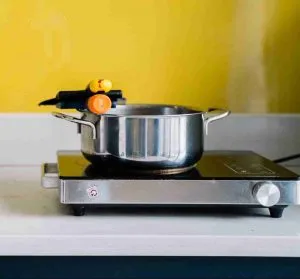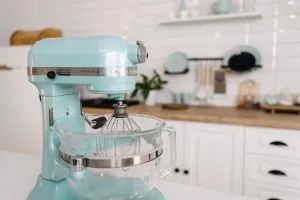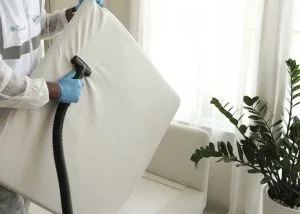Contents
ToggleUnderstanding the Basics: What Are Dehumidifiers, and Why Are They Important?
Before we delve into the nitty-gritty of dehumidifiers, let’s talk about what they are. A dehumidifier is essentially an appliance that reduces the level of humidity in the air. It works by sucking in air, removing moisture, and then blowing the drier air back out.
This simple process plays a crucial role in maintaining healthy indoor air quality. High humidity can lead to a host of issues, from mold growth and damage to your home to allergies and other health problems. Hence, maintaining an optimal level of humidity (usually between 30% and 50%) is important for your health and the longevity of your home.
For more insights into how dehumidifiers function, especially in smaller spaces, here’s an informative article on whether dehumidifiers work in small rooms.
Essential Factors When Selecting a Dehumidifier
Selecting the ideal dehumidifier goes beyond a simple purchase decision. It’s about taking into consideration your unique circumstances to find a solution that best fits your needs. The size of your room, the existing level of humidity, and the type of dehumidifier are all critical factors to weigh in on. Let’s explore these facets in more detail below or check out our ranking with the top 8 dehumidifiers for small rooms straight away!
Assessing Your Room Size
When it comes to dehumidifiers, size is of paramount importance. And by size, we mean the capacity of the dehumidifier, which should align with the size of your room for optimal performance.
For instance, if you have a small room, like a bathroom or a small bedroom, it’s logical to go for a smaller capacity dehumidifier. These units are designed to handle less air volume, making them ideal for smaller spaces.
On the flip side, if you place a small dehumidifier in a large room, it will struggle to effectively reduce the humidity levels. It might run continuously without achieving the desired results, which could lead to higher electricity costs and shorter appliance lifespan due to wear and tear.
Conversely, a dehumidifier that’s too large for a small room could leave the space excessively dry, creating an uncomfortable environment and potentially leading to adverse health effects like dry skin and respiratory problems.
Evaluating Your Humidity Level
Understanding the humidity level in your room is a pivotal factor when selecting a dehumidifier. The degree of humidity will steer the decision toward a dehumidifier with the right power and capacity.
For example, a room that’s mildly damp might not demand a high-powered dehumidifier. On the flip side, a room that resembles a damp, tropical rainforest will necessitate a more powerful unit to effectively lower the humidity.
To determine your room’s humidity level, you can use a hygrometer. This useful device measures the moisture content in the air, providing an accurate reading that will aid you in selecting an appropriately sized dehumidifier. To understand the additional benefits and find an answer to commonly asked questions such as a dehumidifier’s potential to cool a room, it’s worth doing further research.
Deciding on the Type of Dehumidifier
Finally, the type of dehumidifier you choose will largely depend on your specific needs and the size of the space you’re trying to dehumidify. The market offers a variety of dehumidifiers, each with its own strengths and suited to different circumstances.
Portable Dehumidifiers
Portable dehumidifiers are compact, movable units that offer the convenience of addressing humidity problems precisely where they occur. Whether it’s a damp basement, a steamy bathroom, or a small bedroom that feels a bit clammy, these dehumidifiers can be relocated as needed for spot treatment. However, their worthiness as an investment might raise some questions. To help you navigate this decision, you might want to explore this detailed article on the value proposition of small dehumidifiers: Are small dehumidifiers worth it?
Whole-House Dehumidifiers
When dealing with more expansive spaces, or if your goal is to regulate humidity throughout your entire home, a whole-house dehumidifier might be the solution. These units are typically incorporated into your home’s HVAC system, providing the advantage of controlling humidity evenly across all rooms or large areas.
By carefully evaluating these three key aspects—room size, humidity level, and the type of dehumidifier—you can make a well-informed decision about which dehumidifier to purchase. Ultimately, it’s about striking a balance tailored to your specific requirements, ensuring your home remains a comfortable and healthy environment. To further understand when it’s appropriate to use a dehumidifier, check out this resource: When to use dehumidifiers.
How to Measure Your Room
Selecting the right dehumidifier relies heavily on knowing the exact measurements of your room. This involves more than just a rough estimate. Here’s a step-by-step process to obtain accurate room measurements:
- Measure the length and width of your room: Start by measuring the length and width of your room in feet. Use a tape measure and record the measurements. Multiply these two figures together to get the total square footage of your room. For instance, if your room is 10 feet long and 12 feet wide, the total square footage is 120 square feet.
- Measure the height of your room: Next, measure the height of your room from the floor to the ceiling. This is a crucial step, particularly for rooms with high ceilings. A room with a higher ceiling contains a larger volume of air for the dehumidifier to process, necessitating a higher capacity dehumidifier.
Remember, the objective is to dehumidify the entire volume of air in your room, not just the area at floor level.
Calculating the Dehumidifier Size You Need
Having determined your room’s measurements and identified your humidity level, it’s time to calculate the ideal dehumidifier size.
Dehumidifiers are rated based on the amount of moisture they can remove from the air in a 24-hour period, measured in pints. For instance, a dehumidifier with a capacity of 10 pints can remove up to 10 pints of water from the air in a day.
For a small room exhibiting mild dampness, a dehumidifier with a capacity of up to 10 pints might be sufficient. However, if the same room has a higher humidity level—say, it feels consistently wet—a dehumidifier with a capacity of up to 16 pints may be necessary.
To make things easier, there are online calculators available that help you determine the ideal dehumidifier capacity based on your room size and humidity level. These calculators provide a helpful starting point, but remember that they offer guidelines, not hard and fast rules.
Other factors can influence the humidity levels in your room and, consequently, the dehumidifier size you need. These include the number of windows and doors in the room, the level of insulation, the amount of airflow, and the number of people regularly occupying the room. Each of these factors can contribute to the overall moisture content in the room.
By taking a comprehensive approach to measuring your room and understanding the factors that influence humidity, you can make an informed decision on the ideal dehumidifier size for your needs. It’s about creating a comfortable and healthy living environment for you and your loved ones.
| Room Size/Relative Humidity Level | 400 Sq. Ft. | 600 Sq. Ft. |
|---|---|---|
| Moderately Damp (50-60% RH) | 10-12 Pints | 14-16 Pints |
| Very Damp (60-70% RH) | 12-14 Pints | 16-18 Pints |
| Wet (70-80% RH) | 14-16 Pints | 18-22 Pints |
| Extremely Wet (80-100% RH) | 16-20 Pints | 22-26 Pints |
Note: The dehumidifier size is measured in pints of moisture removed per 24 hours. These are rough estimates, and actual needs may vary depending on other factors such as the number of windows, the room’s insulation, the amount of airflow, etc. Always consult a professional or use an online calculator for more accurate sizing.
Choosing the Right Type of Dehumidifier
Selecting the ideal dehumidifier is a balance of personal needs, room dimensions, and financial considerations. Here, we’ll deep dive into two primary categories of dehumidifiers—portable and whole-house—and explore how to maintain your chosen unit for sustained efficiency.
Portable Dehumidifiers: Compact and Versatile
Portable dehumidifiers are the epitome of convenience. They’re compact, easy to maneuver, and tailor-made for smaller rooms or specific areas in your home battling excess humidity.
If you’re grappling with a small room that feels damp and uncomfortable, a portable dehumidifier might be the solution you’re seeking. These units are designed to pull moisture from the air in smaller spaces effectively, helping to create a healthier, more comfortable environment.
Additionally, portable dehumidifiers are generally more wallet-friendly, making them a popular choice among homeowners who need a quick, cost-effective solution to humidity issues in specific areas of their homes.
Whole-House Dehumidifiers: Broad Scope and Efficiency
Whole-house dehumidifiers represent the other end of the spectrum. As the name suggests, these units are designed to manage humidity levels throughout your entire home. They are integrated into your existing HVAC system, allowing them to dehumidify air as it circulates through your heating and cooling system.
While whole-house dehumidifiers are typically more expensive and require professional installation, their benefits are significant, particularly for larger homes or homes located in regions with consistently high humidity. They provide a comprehensive solution, ensuring that every room in your house maintains a comfortable humidity level.
Maintenance and Care
Once you’ve selected and installed your dehumidifier, ongoing maintenance and care are crucial to ensure its effective operation over time. Here are a few essential tips:
- Regularly Empty the Reservoir: Dehumidifiers work by pulling moisture out of the air and depositing it into a built-in reservoir or water tank. Many of these units come equipped with a helpful auto shut-off feature that kicks in when the tank is full, preventing any potential overflows. To keep your dehumidifier running smoothly without interruption, it’s crucial to frequently empty this reservoir. You might wonder what to do with the water collected by the dehumidifier. If so, here’s an interesting read on whether the water from a dehumidifier is distilled and how it can be used.
- Keep the Filters Clean: Dehumidifiers are equipped with filters, whose job is to catch dust, allergens, and other airborne particles. However, over time, these filters can get clogged, thereby diminishing the unit’s performance. Regular maintenance, which includes cleaning or replacing these filters as per the manufacturer’s guidelines, is necessary for the smooth operation of your dehumidifier. If you notice your dehumidifier behaving unusually, like blowing hot air, it might be a good time to check and clean your filters.
- Optimize Placement: The location of your dehumidifier in a room plays a critical role in its effectiveness. For optimal humidity control, situate your dehumidifier in a central spot, ensuring it’s away from walls and large pieces of furniture. This arrangement promotes better air circulation. Moreover, keeping doors and windows shut while the unit is operating can prevent the influx of additional humid air. If your dehumidifier isn’t functioning as expected, such as icing up, placement could be one of the factors to review.
- Schedule Regular Maintenance: If you opt for a whole-house dehumidifier, regular professional maintenance is beneficial to ensure the unit’s continued efficiency and longevity.
Choosing the right dehumidifier for your small room doesn’t have to feel like a monumental task. With an understanding of your room’s dimensions, the prevailing humidity level, and the type of dehumidifier that suits your circumstances, you can create a healthier, more comfortable living environment with ease.
FAQ
Is a 10 Litre dehumidifier enough?
A 10-liter dehumidifier may be suitable for a small room or space exhibiting mild dampness. However, if the room is larger or has high humidity levels, you may need a unit with a larger capacity.
What size dehumidifier do I need for a 1 bedroom flat?
The size of the dehumidifier you need for a one-bedroom flat largely depends on the humidity level. Generally, a dehumidifier with a capacity between 10 to 16 pints (about 4.7 to 7.6 liters) should be adequate for a moderately damp flat.
How do I know what size dehumidifier I need?
To determine the size of the dehumidifier you need, measure the size of your room, evaluate the level of dampness or humidity, and refer to the manufacturer’s guidelines or use an online calculator to match these factors to the correct capacity.
How big dehumidifier do I need Litres?
The size of the dehumidifier you need in liters depends on the room size and dampness level. For instance, a mildly damp small room may need a 10-liter dehumidifier, while a larger, very damp room may require a 20-liter or larger unit.























































